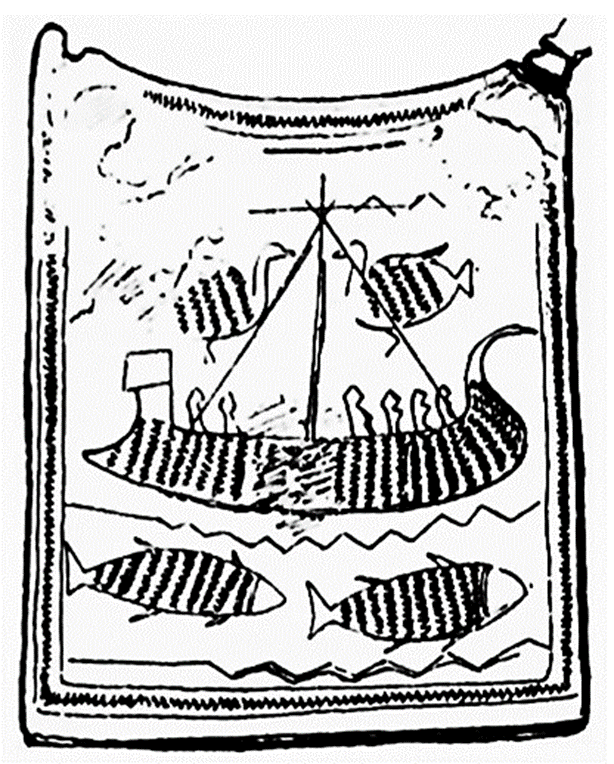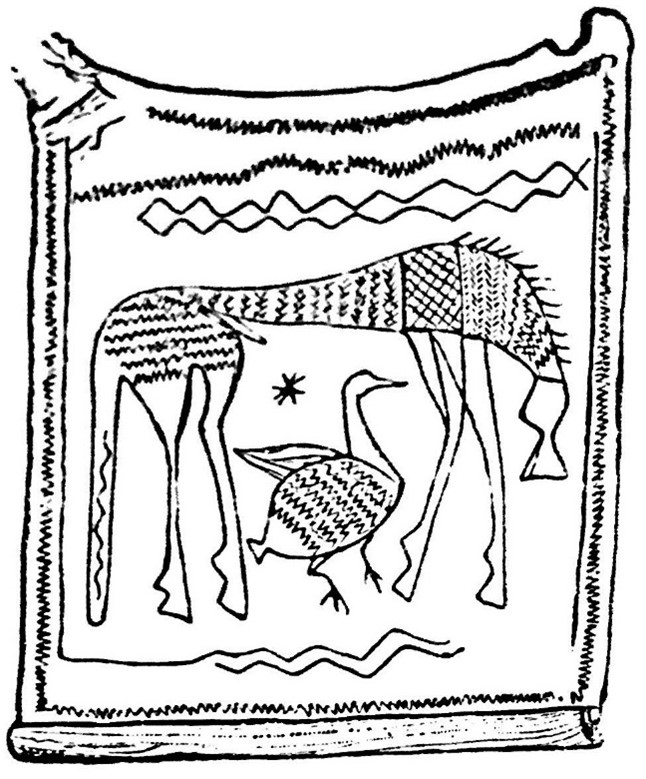Single-levelled ship to the left with a slightly rockered hull. Massive bow with a concave stempost integrating the ram. The stempost has no decoration, with a solid integrated forecastle capped by a rectangular extremity whose outer edge protrudes slightly in front of the stempost. The ram is short and thick, curving slightly upward in a natural continuation of the keel line. High incurving sternpost ending in a horn-shaped device that rises vertically then curves outward parallel to the hull. The mast is amidships and fitted with a bisected V at the top, with a fore- and backstay. It is tempting to interpret the horizontal line at the juncture where the mast is forked as the yard, but none of the fibulae parallels have this element so this is unlikely. The hull is decorated by a series of vertical parallel zigzag lines, the same motif that is used for the bodies of the fish and the birds. The figures sit upright facing right, with two fore and four aft. The hull is much tubbier and rockered compared to ships depicted on other contemporary fibulae. The mast forking at the top with two stays is standard for the medium and is observable on four other fibulae. Two broken lines of waves are an element that is never depicted on pottery
Single-levelled galley
A58
c. 700 B.C.
Woman's grave near Thebes, Boeotia
H: 12 cm; L: 27.5 cm
Bronze fibula with decorated catch-plate and a bow comprised of four shells. Attributed to the "boat master"/ship engraver artist
Louvre
Basch 1987: 195, no. 415; Hampe 1936: no. 133; Morrison and Williams 1968: 79, Arch. 23
From a woman's grave, found alongside three other bronze fibulae, an intaglio and strips of gold decorated with geometric motifs. The large size and shape of the fibula are characteristic for the region. Its principal feature is the rectangular catchplate decorated with finely incised decorative motifs, with its lower edge forming the catch of the pin. The bow is formed by a row of four shells engraved with lines and zigzags. The plaque displays a decoration combining an animal theme and a narrative scene.(Side A): a ship facing left with six seated figures, floating above a broken line of waves and framed by two antithetical birds (one on either side of the mast) and two fish below swimming to the right. (Side B): a grazing horse with its head lowered, with a bird with outspread wings between its legs. The remainder of the space is filled with additional motifs, including stars, zigzags, and chevrons. The rendering and motifs have been interpreted as reflecting a transition between two stylistic trends: the geometric style of the EIA and the more "Orientalizing" features of the subsequent period. The composition and treatment of the ship's rigging find parallels that have been attributed to the artist dubbed the "Boatmaster" or Ship Engraver
Basch, L. 1987. Le musée imaginaire de la marine antique. Athens: Institut Hellénique pour la preservation de la tradition nautique.
Hampe, R. 1936. Frühe griechische Sagenbilder in Böotien, Ate¬ne : Deutsches archäologisches institute.
Morrison, J.S. and R.T. Williams. 1968. Greek Oared Ships: 900-322 B.C. Cambridge: Cambridge University Press.





